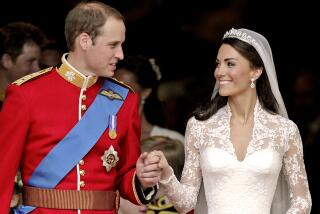Book review: An engaging portrait of ‘Catherine the Great’
She rejected the title by which posterity knows her, preferring always to conceal her steely ambition and regal pride under a mask of modesty and service. Yet “Catherine the Great” was indeed an apt sobriquet for the subject of Robert K. Massie’s latest foray into imperial biography (following the bestselling “Nicholas and Alexandra” and the Pulitzer Prize-winning “Peter the Great”).
Born into the provincial German nobility, Catherine rose to seize the Russian crown from an unpopular husband and rule her adopted homeland for 34 years, confirming it as a major European power with victories over the Ottoman Empire and three ruthless partitions of Poland.
“A majestic figure in the age of monarchy,” as Massie rightly puts it, Catherine was also a proto-modern politician who understood the value of good publicity. She cultivated it by patronizing French Enlightenment philosophes Voltaire and Diderot, who viewed her as a model of the kind of benevolent autocrat they hoped would rationalize and reform the 18th century’s ossified, oppressive kingdoms. Catherine shared some of these hopes, but she was able to promulgate only limited change in the face of opposition from the Russian nobility, whose support was imperative for a foreign-born usurper plagued by revolts aiming to restore a male Romanov to the throne.
She was born Sophia Augusta Fredericka on April 21, 1729, the offspring of a minor German prince and his bored teenage wife, who displayed little affection for her clever, fun-loving daughter. Massie, an engaging practitioner of traditional history focused on individual personalities, suggests that throughout her life, “even as Empress Catherine,” she yearned for the warmth and love she missed as a child. She would not find them with Peter, the German-born nephew and heir of Russia’s childless Empress Elizabeth.
Summoned to Moscow to be betrothed to Peter in 1744, Catherine quickly realized that her sullen fiancé had failed to ingratiate himself with Elizabeth and that her future in Russia depended on producing “a child better equipped than his father to guarantee the succession.” That wasn’t going to be easy, since their marriage was probably never consummated; Paul, the son Catherine finally bore in 1754, was probably fathered by her first lover, a Russian nobleman shoved into her arms by imperial watchdogs determined to fulfill Elizabeth’s desire for the next generation of Romanovs.
Massie devotes fully half his text to a vivid narrative of the difficult years prior to Elizabeth’s death in late 1761. We see Catherine developing the formidable skills she would ably deploy as empress. She adroitly handled her puerile husband and his imperious aunt with a guileful blend of charm, submissiveness and carefully chosen moments of defiance. She cultivated supporters in the Russian aristocracy alienated by Peter’s worship of all things German. Catherine, by contrast, adopted the Orthodox faith and quickly learned to speak fluent Russian. When Peter, upon acceding to the throne, secularized all Russian church property and switched sides to support Prussia in the Seven Years’ War, the stage was set for the bloodless coup that made Catherine empress in June 1762: Peter, strangled by her supporters probably without Catherine’s knowledge, was the only casualty.
Covering Catherine’s long reign, Massie’s approach becomes more episodic. It makes sense to have individual chapters on topics that spread over a number of years, such as the Nakaz, the Enlightenment-inflected document Catherine drew up as a guideline for the legislative committee she called to assist her in creating a new code of laws, or her long personal and professional relationship with Gregory Potemkin, her chief minister (and possibly her husband) from 1774 until 1791.
A few self-indulgent passages — the irrelevant history of an aristocrat who married a serf, some bizarre musings on how long it takes to die after being guillotined — exceed the proper limits of this approach. In general, however, the chronology moves forward, and the main outlines are clear: Catherine was a hardworking, well-informed ruler with leanings toward humane reform but with a firm belief that Russia could be governed only by an absolute monarch. Her more repressive attitude in the years before her death in 1796, when she instituted censorship and jailed a nobleman who advocated the gradual abolition of serfdom stemmed from her horror at the French Revolution and her fear that its regicidal ideas would spread to Russia.
Massie deals briskly with the increasingly younger and dumber favorites who succeeded Potemkin in Catherine’s bed, though not in her government, noting that such arrangements were hardly unusual at the time. This is indeed a “Portrait of a Woman,” as the subtitle declares, with plenty of attention paid to Catherine’s emotions and psychology. It is also an adept portrait of a ruler, sympathetically assessing Catherine as a worthy successor to Peter the Great in the effort to modernize and westernize the vast Russian empire. Historians may wish Massie had devoted more time to underlying forces in Russian society that defined the limits of Catherine’s achievements, but general readers will find this an absorbing, satisfying biography of the old school.
“Catherine the Great: Portrait of a Woman”
By Robert K. Massie
Random House, 625 pages, $35
Smith is a contributing editor for the American Scholar and reviews books for The Times, the Chicago Tribune and the Washington Post.
More to Read
Sign up for our Book Club newsletter
Get the latest news, events and more from the Los Angeles Times Book Club, and help us get L.A. reading and talking.
You may occasionally receive promotional content from the Los Angeles Times.






